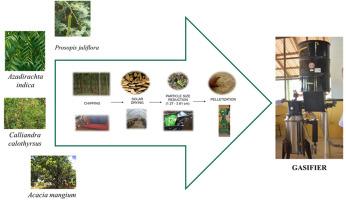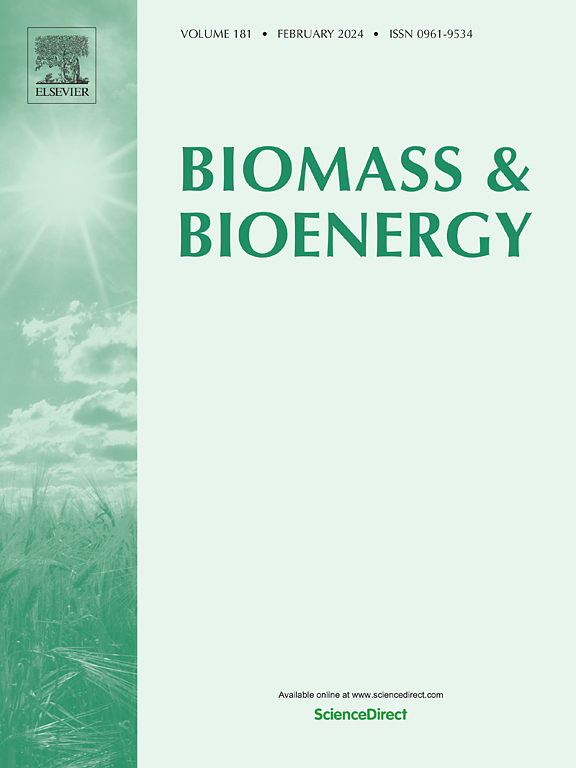Characterization and pilot-scale downdraft gasification of invasive forestry species biomass in the Dominican Republic
IF 5.8
2区 生物学
Q1 AGRICULTURAL ENGINEERING
引用次数: 0
Abstract
In many developing countries, the primary source of energy generation is fossil fuels. However, the study and utilization of invasive forestry species for gasification can help transition away from fossil fuels and towards sustainable, renewable energy production. In the present work, we investigated the characterization and energy potential of four invasive forestry species (Prosopis juliflora, Azadirachta indica, Acacia mangium, and Calliandra calothyrsus) affecting the dry and rain forests of the Dominican Republic. We analyzed the parts (wood, bark, and branches), and transverse diameter sizes (less than 2.5 cm, 2.5–5.0 cm, and 5.0 cm) of the invasive forestry species. Additionally, we evaluated the calorific value, composition, and quality indicators of the syngas produced by these species using a downdraft gasifier. Fixed carbon, ash, and moisture content were higher in the bark compared to the wood and branches of the forestry species. Also, lower the thickness of the species branches tended to have higher moisture and ash content. A. mangium had the highest energy potential with calorific values of 20.4 MJ/kg for the biomass and 5.22 MJ/m3 for the syngas. The species P. juliflora showed a calorific value of 18.6 MJ/kg and syngas with 5.08 MJ/m3. However, the gasifier cold gas efficiency of the species P. juliflora obtained of 24.89 % which was slightly higher than A. mangium with 23.29 % based on the conversion ratio of biomass to gas. Our findings reveal the promising potential of P. juliflora, a relatively underexplored biomass, as a viable feedstock for gasification-based bioenergy production.

多米尼加共和国入侵林木物种生物质的特征描述和下行气化试验规模
在许多发展中国家,能源生产的主要来源是化石燃料。然而,研究和利用入侵林木物种进行气化,有助于从化石燃料过渡到可持续的可再生能源生产。在本研究中,我们调查了影响多米尼加共和国干旱和雨林的四种入侵林业物种(Prosopis juliflora、Azadirachta indica、Acacia mangium 和 Calliandra calothyrsus)的特征和能源潜力。我们分析了入侵林木的部位(木材、树皮和树枝)和横向直径大小(小于 2.5 厘米、2.5-5.0 厘米和 5.0 厘米)。此外,我们还评估了这些树种使用下吹气化炉产生的合成气的热值、成分和质量指标。与林木和树枝相比,树皮中的固定碳、灰分和水分含量更高。此外,树枝越粗,水分和灰分含量越高。芒果的能量潜力最高,生物质的热值为 20.4 兆焦/千克,合成气的热值为 5.22 兆焦/立方米。P. juliflora 的热值为 18.6 MJ/kg,合成气为 5.08 MJ/m3。然而,根据生物质与气体的转化率,茱莉花的气化炉冷气效率为 24.89%,略高于芒果的 23.29%。我们的研究结果揭示了茱莉花这一相对未充分开发的生物质作为气化生物能源生产的可行原料的巨大潜力。
本文章由计算机程序翻译,如有差异,请以英文原文为准。
求助全文
约1分钟内获得全文
求助全文
来源期刊

Biomass & Bioenergy
工程技术-能源与燃料
CiteScore
11.50
自引率
3.30%
发文量
258
审稿时长
60 days
期刊介绍:
Biomass & Bioenergy is an international journal publishing original research papers and short communications, review articles and case studies on biological resources, chemical and biological processes, and biomass products for new renewable sources of energy and materials.
The scope of the journal extends to the environmental, management and economic aspects of biomass and bioenergy.
Key areas covered by the journal:
• Biomass: sources, energy crop production processes, genetic improvements, composition. Please note that research on these biomass subjects must be linked directly to bioenergy generation.
• Biological Residues: residues/rests from agricultural production, forestry and plantations (palm, sugar etc), processing industries, and municipal sources (MSW). Papers on the use of biomass residues through innovative processes/technological novelty and/or consideration of feedstock/system sustainability (or unsustainability) are welcomed. However waste treatment processes and pollution control or mitigation which are only tangentially related to bioenergy are not in the scope of the journal, as they are more suited to publications in the environmental arena. Papers that describe conventional waste streams (ie well described in existing literature) that do not empirically address ''new'' added value from the process are not suitable for submission to the journal.
• Bioenergy Processes: fermentations, thermochemical conversions, liquid and gaseous fuels, and petrochemical substitutes
• Bioenergy Utilization: direct combustion, gasification, electricity production, chemical processes, and by-product remediation
• Biomass and the Environment: carbon cycle, the net energy efficiency of bioenergy systems, assessment of sustainability, and biodiversity issues.
 求助内容:
求助内容: 应助结果提醒方式:
应助结果提醒方式:


